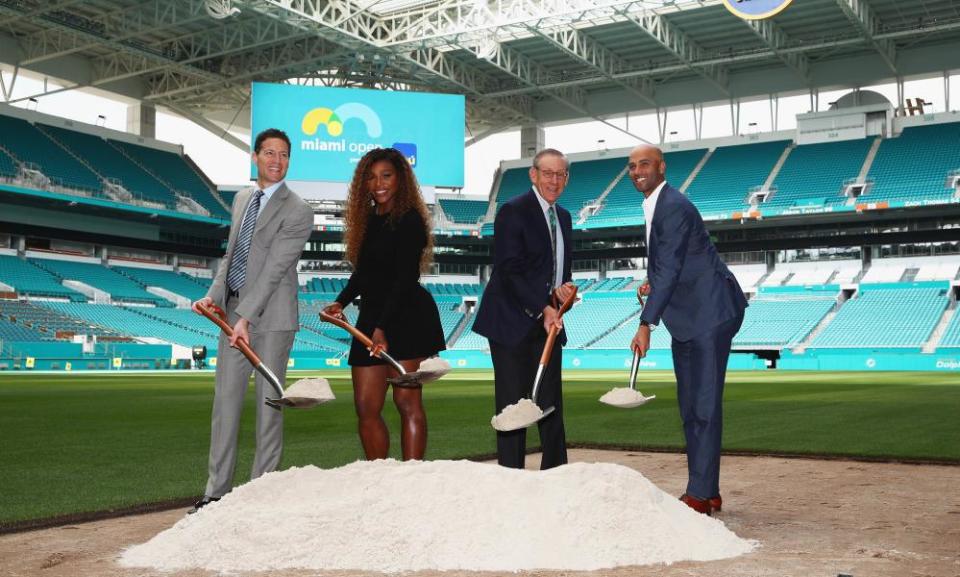Why is the Miami Open moving to a 65,000-capacity NFL stadium?
The tournament is leaving behind the cramped confines of Crandon Park. But will it lose its famous atmosphere in a cavernous new home?

When the last ball is hit at the Miami Open in Key Biscayne this weekend, tennis sentimentalists will shed a tear. For the past 32 years Crandon Park has hosted a tournament once heralded as the ‘fifth slam’, a moniker which has weakened along with the decay of a venue badly in need of an update it will never get.
Instead, with upgrades blocked by legal wranglings and environmental concerns, the tournament will move north to the recently renovated Hard Rock Stadium, home of the Miami Dolphins.
“We opposed [upgrading the site] because of the commercialisation of a privately dedicated public park which was given for public park purposes only,” Bruce Matheson, whose family have owned large parts of Key Biscayne since 1908, told the Guardian. “The agreement was that only one permanent stadium would be built.”
But will playing tennis in a 65,000 capacity NFL stadium be strange? Particularly when the current largest tennis venue in the world, the 23,000-seater Arthur Ashe Stadium, is often criticised for its lack of atmosphere.
“I am really sad to see [the Miami Open leave Crandon Park],” says Caroline Wozniacki, the Australian Open champion who owns an apartment in the city. “It would have been amazing if it would’ve stayed and expanded. In my head having been to the football stadium, I have a hard time seeing how everything will work out, how it’s going to feel as cozy and special as it does here.”
The main stadium at Crandon Park may have been aging but it was known for the way local Latino fans could create an intense atmosphere. The Argentinians in particular have flocked to this tournament and raised the roof for Juan Martin del Potro over the past 12 days. That may be difficult to do in a much larger venue. It’s perhaps too early to tell but at Hard Rock Stadium there’s no history, no romance and no real feel that you’re in Miami other than the realization that you’re driving down Dan Marino Boulevard. Meanwhile, the scenic daily route into Key Biscayne is awash with palm trees and blue waters while Hard Rock Stadium has a freeway. You really could be anywhere in the US.
For some though, the move is an opportunity to live out their childhood dreams. “It’s going to be like a day in the life of an NFL player,” enthused US world No11 Jack Sock, a huge Kansas City Chiefs fan. “I am excited to go there, see the locker rooms.”
Not that the stands of Hard Rock Stadium will be heaving with fans. Only around 14,000 of the 65,000 capacity will be in use with large drapes masking a sea of empty seats. A massive temporary, three-sided stand will be erected on the field to bring spectators closer to the action thus leaving one side of the arena totally unused. The infrastructure for a new Grandstand court, with much needed gym facilities, will also be built along with new hospitality areas. Fans will be able to keep up with the action thanks to huge screens erected outside the main stadium. The computer renderings of the site look impressive – as do plans for landscaping in the area to give the tournament more of a tennis feel.
Many people who work inside tennis are skeptical about the plans. Nevertheless, the $60m upgrade will allow the Miami Open to compete with Indian Wells, the tournament owned by tech billionaire Larry Ellison that has become the mythical extra major Miami used to be thanks to huge investment in the infrastructure (the main 16,000 stadium in the California desert is the second biggest outdoor tennis arena in the world).
“Both are great tournaments but the permanent structures in Indian Wells make a difference,” added another source.
That could be about to change. Dolphins owner and tennis fan Stephen Ross, along with Serena Williams who is a part owner of the NFL team and has been a sounding board during the whole process, was rolled out at an official announcement two weeks ago. The billionaire gleefully spoke of a glittering future for a tournament which has aged badly.
There will be a total of 30 courts at the new site – for practice and tournament play – including the main stadium (Key Biscayne has 18), more space and crucially, more chance of keeping the players happy. There are also vastly superior catering options. The ability to host sponsors in plush, luxury suites which generate huge amounts of cash during the NFL season are also, predictably, attractive reasons for the switch.
“Stephen Ross is helping to progress the sport,” James Blake, the former world no4 who is the Miami Open’s new tournament director, told the Guardian. “A lot of the top players have been kept in the loop. They need to be happy and we need to make sure we don’t miss anything. The courts, facilities, the food , the locker rooms.”
It’s sure be glitzy, loud and lively – IMG will dig deep into their musical and entertainments contacts to reinforce what they call the ‘festivalisation’ of the event – even if the lack of palm trees and the constant noise emanating from the Florida Turnpike will take away the Floridian experience which made picturesque Key Biscayne such a favourite with fans and players alike.
Wozniacki may not be alone in her caution about changing a beloved tournament but change, even if it does obliterate sentimentality, seems to be the only way ahead.

